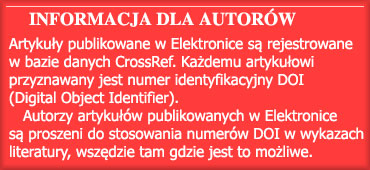 Spis tresci zeszytu Elektronika nr 10/2021
NARDA EFC-400. PROGRAMOWANIE DO OBLICZEŃ PÓL
ELEKTROMAGNETYCZNYCH WYTWARZANYCH PRZEZ SIECI
ENERGETYCZNE I STACJE BAZOWE TELEFONII KOMÓRKOWEJ
J. KWIATKOWSKI
Spis tresci zeszytu Elektronika nr 10/2021
NARDA EFC-400. PROGRAMOWANIE DO OBLICZEŃ PÓL
ELEKTROMAGNETYCZNYCH WYTWARZANYCH PRZEZ SIECI
ENERGETYCZNE I STACJE BAZOWE TELEFONII KOMÓRKOWEJ
J. KWIATKOWSKI......................2
SZPITAL NA KRAWĘDZI, CZYLI JAK SZTUCZNA INTELIGENCJA
WSPOMAGA PRACĘ SYSTEMU OPIEKI ZDROWOTNEJ .......6
POLSKI STARTUP ŚLEDZI AWARIE PRZY WSPARCIU SIECI 5G .......7
ELEKTRONARZĘDZIA ZASILANE BATERYJNIE Z SILNIKIEM
PRĄDU STAŁEGO .......8
PIERWSZY SAMOLOT BOEING 737-8200 W WARSZAWIE .......8
CZYNNIKI WPŁYWAJĄCE NA BŁĘDY POMIARU IMPEDANCJI W SIECIACH
ELEKTROENERGETYCZNYCH WYSOKIEGO NAPIĘCIA
(Factors influencing errors in impedance measurements
in high voltage power networks)
A. SKUZA, M. SUPRONIUK......................9
Streszczenie
Artykuł powstał na podstawie pracy dyplomowej zrealizowanej
w Wojskowej Akademii Technicznej. Wyniki opisujące zagadnienia
pomiaru impedancji w sieciach elektroenergetycznych
wysokiego napięcia pozwoliły na analizę możliwości sfałszowania
pomiarów w wyniku powstania zakłóceń. Przedstawiono
przebiegi napięć i prądów podczas zwarcia bezpośredniego pośredniego
oraz podczas pracy dwóch źródeł na zwarcie, a także
przebiegi impedancji podczas kołysań mocy.
SŁOWA KLUCZOWE:elektroenergetyka, zabezpieczenia odległościowe,
pomiar impedancji
ABSTRACT
The article is based on the diploma thesis carried out at the
Military University of Technology. The results describing the
impedance measurement issues in high voltage power networks
allowed for the analysis of the possibility of falsifying
the measurements as a result of disturbances during normal
and fault operations. Voltage and current waveforms during
a direct indirect short-circuit, during operation of two sources on
short-circuit and impedance waveforms during power swings
were presented.
KEYWORDS:power engineering, distance protection, impedance
measurement
SPOSOBY OGRANICZANIA ZUŻYCIA ENERGII BEZPRZEWODOWYCH
SENSORÓW MEMS
(Methods to reduce energy consumption of wireless MEMS sensors)
M. OSINIAK, Z. PIÓRO, E. ANTOSZKIEWICZ, L. ŁUKASIAK...............14
Streszczenie
Przedstawiono konieczność wyboru pomiędzy tłumieniem
względnie dużych szumów sensorów MEMS (rozdzielczością
pomiaru) a zużyciem energii z baterii zasilających węzły sensoryczne
dla zastosowań w IoT. Zaproponowano dwa niekonwencjonalne
rozwiązania tego problemu pozwalające radykalnie
zmniejszyć zużycie energii przy zachowaniu parametrów
filtracji (rozdzielczości pomiaru).
SŁOWA KLUCZOWE:monitoring konstrukcji dachów, inklinometr
MEMS, szumy sensorów MEMS, filtracja szumów
ABSTRACT
The need to choose between the damping of relatively high
noise of MEMS sensors (measurement resolution) and the energy
consumption from batteries powering sensor nodes for
IoT applications is presented. Two unconventional solutions to
this problem have been proposed allowing to radically reduce
energy consumption while maintaining filtration parameters
(measurement resolution).
KEYWORDS:roof construction monitoring, MEMS inclinometer,
noise of MEMS sensors, noise dumping
DEKOHERENCJA KWANTOWA
(Quantum decoherence)
R. ROMANIUK..........18
Streszczenie
Artykuł jest kolejną częścią dydaktycznego cyklu swobodnych
popularnych esejów na temat informacyjnych technologii kwantowych.
Cykl tematyczny ITK został rozpoczęty w styczniowym
zeszycie Elektroniki 1/2021 i pokrywał się z prowadzonymi przez
autora wykładami dla doktorantów na ten temat na Wydziale
Elektroniki i Technik Informacyjnych Politechniki Warszawskiej.
Dekoherencja kwantowa jest nietrywialnym i złożonym procesem
przejścia przez niedokładnie znaną granicę między światami
kwantowym i klasycznym. Niedokładność wiedzy o tej granicy
dotyczy jej położenia, rozmycia w kwantowej i klasycznej przestrzeniach
fazowych, wymiarów obszaru przejściowego, właściwości
fizycznych, zakresu obowiązywania praw obu światów
w pobliżu tej granicy, różnorodności kanałów przechodzenia
granicy, zadziwiającej selektywności i wybiórczości (nazywanej
superselekcją/nadwyborem) dekoherencyjnych sprzężeń różnych
stanów obiektu kwantowego (tutaj kubitu) z przestrzenią
termodynamiczną, itp. Ta granica musi pozostać rozmyta, bo
prawa prawdopodobieństwa i znajomość stanów są różne po
obu jej stronach. Kubit przechodząc proces dekoherencji podlega
wymienionym zjawiskom w obszarze granicznym zależnie
od właściwości kanałów dekoherencji które go dotyczą. Ogólnie
kanały dekoherencji są związane z nieuchronnym sprzężeniem
kubitu ze światem makroskopowym, nazywanym tutaj klasycznym
lub przestrzenią termodynamiczną. Kanałami dekoherencji
są zakłócenia i szumy kwantowe. W komputingu kwantowym
stan kubitu mierzymy po wykonaniu cyklu obliczeń kwantowych.
Sprzęt pomiarowy i proces pomiaru są kanałami dekoherencji.
Pomiar jest procesem gwałtownym i nieodwracalnym transformującym
kwantowy kubit do świata klasycznego. W czasie obliczeń
może dochodzić do częściowej dekoherencji stanu kubitu. Może
to być proces odwracalny metodami kwantowymi.
SŁOWA KLUCZOWE:koherencja kwantowa, dekoherencja kwantowa,
superpozycja kwantowa, kwantowa przestrzeń fazowa,
splątanie kwantowe, szum kwantowy, granica między światem
kwantowym i klasycznym, kubit, komputing kwantowy
ABSTRACT
This article is the next part of a didactic series of popular essays
on quantum information technology. The QIT thematic cycle was
started in the January issue of Electronics monthly Journal and
coincided with the author’s lectures on this topic for PhD students
at the Faculty of Electronics and Information Technology
of the Warsaw University of Technology. Quantum decoherence is
a non-trivial and complex process of passing through an inaccurately
known boundary between the quantum and classical
worlds. The inaccuracy of knowledge about this border concerns
its location, blurring in quantum and classical phase spaces, dimensions
of the transition region, physical properties, the scope
of the laws of both worlds near this border, the diversity of the
border crossing channels, astonishing selectivity of decoherence
couplings (superselection) between different quantum states of
quantum object (qubit) with thermodynamic space, etc. This border
must remain blurred and fuzzy because the laws of probability
and knowledge of the states are different on both sides. The
qubit undergoing the process of decoherence is subject to the
above-mentioned phenomena in the border area depending on the
properties of the decoherence channels that concern it. Generally,
the decoherence channels are associated with the inevitable coupling
of the qubit with the macroscopic world, hereinafter referred
to as the classical, macroscopic, or thermodynamic space. The
channels of decoherence are interference and quantum noise. In
quantum computing, the state of a qubit is measured after the cycle
of quantum computations. The measurement equipment and the
measurement process are channels of decoherence. Measurement
is a violent and irreversible process transferring the qubit to the
classical world. During the calculations, there may be a partial
decoherence of the qubit state. It could be a process that can be
reversed by quantum methods.
KEYWORDS:quantum coherence, quantum decoherence, quantum
superposition, quantum phase space, quantum entanglement,
quantum noise, quantum-classical boundary, qubit, quantum
computing

 Spis tresci zeszytu Elektronika nr 10/2021
Spis tresci zeszytu Elektronika nr 10/2021